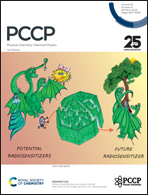Dehydrogenation of diborane on small Nbn+ clusters†
Abstract
The reactivity of Nbn+ (1 ≤ n ≤ 21) clusters with B2H6 is studied by using a self-developed multiple-ion laminar flow tube reactor combined with a triple quadrupole mass spectrometer (MIFT-TQMS). The Nbn+ clusters were generated by a magnetron sputtering source and reacted with the B2H6 gas under fully thermalized conditions in the downstream flow tube where the reaction time was accurately controlled and adjustable. The complete and partial dehydrogenation products NbnB1–4+ and NbnB1–4H1,2,4+ were detected, indicative of the removal of H2 and likely BHx moieties. Interestingly, these NbnB1–4+ and NbnB1–4H1,2,4+ products are limited to 3 ≤ n ≤ 6, suggesting that the small Nbn+ clusters are relatively more reactive than the larger Nbn>6+ clusters under the same conditions. By varying the B2H6 gas concentrations and the reactant doses introduced into the flow tube, and by changing the reaction time, we performed a detailed analysis of the reaction dynamics in combination with the DFT-calculated thermodynamics. It is demonstrated that the lack of cooperative active sites on the Nb1+ cations accounts for the weakened dehydrogenation efficiency. Nb2+ forms partial dehydrogenation products at a faster rate. In contrast, the Nbn>6+ clusters are subject to more flexible vibrational relaxation which disperse the energy gain of B2H6-adsorption and thus are unable to overcome the energy barriers for subsequent hydrogen atom transfer and H2 release.



 Please wait while we load your content...
Please wait while we load your content...